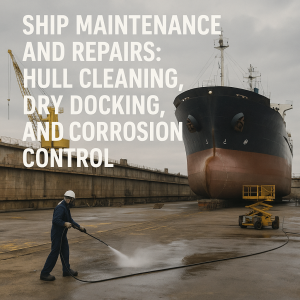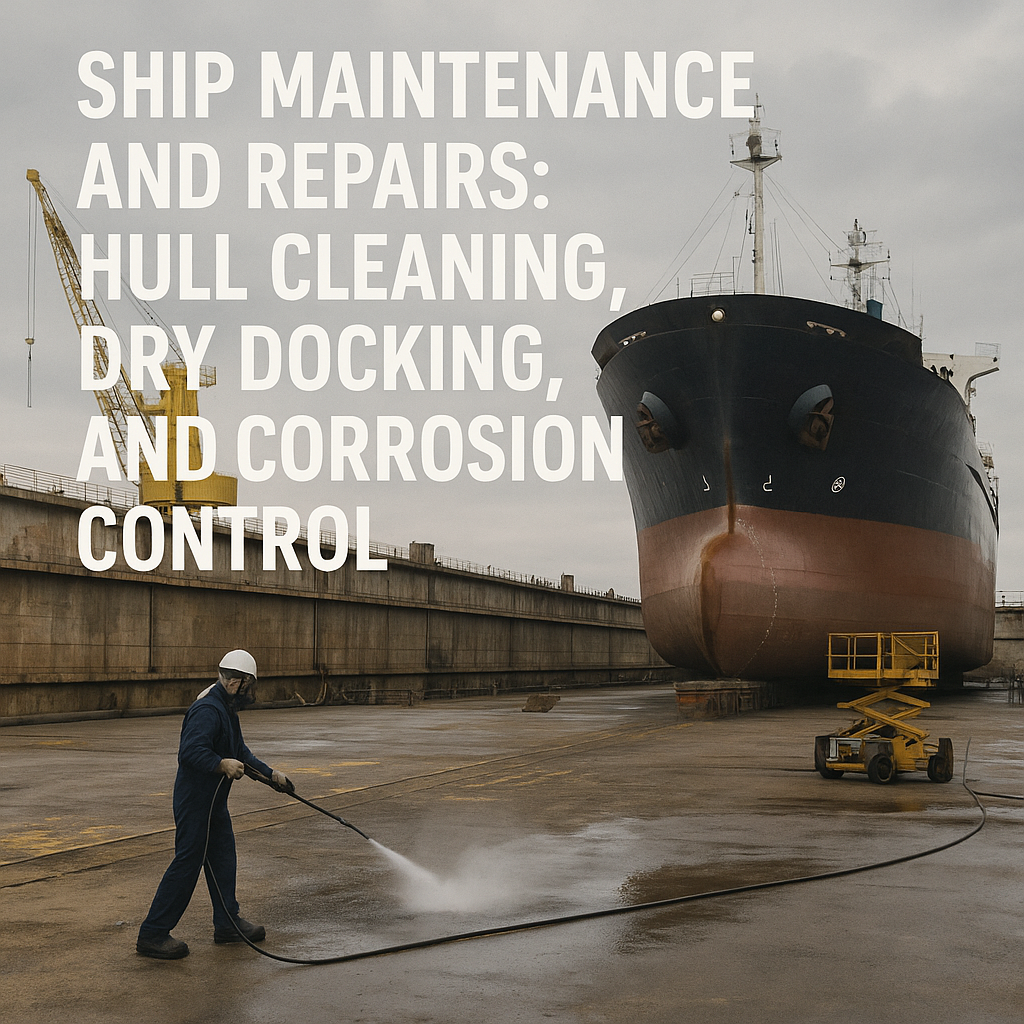Explore essential ship maintenance practices including hull cleaning, dry docking, and corrosion control. Learn how modern methods and technologies protect vessels, reduce costs, and ensure maritime safety.

Maritime operations are relentless, and the sea—magnificent though it is—can be harsh on ships. Saltwater, biofouling, metal fatigue, and long voyages take their toll. This is why ship maintenance isn’t just a checklist; it’s a critical lifeline for the global shipping industry.
Why Ship Maintenance Matters in Modern Maritime Operations
Imagine driving a car that hasn’t been serviced in years—oil unchanged, brakes worn, tires bald. Now picture that on a vessel 300 meters long, hauling oil, containers, or people across oceans. Proper ship maintenance keeps vessels seaworthy, extends their operational life, improves fuel efficiency, and most importantly, safeguards human life and marine environments.
According to a 2023 IMO report, over 25% of maritime casualties involved mechanical or hull-related issues, many of which could have been prevented with better maintenance protocols.
Understanding the Core Components of Ship Maintenance
Modern ship maintenance can be grouped into three interrelated domains:
Hull Cleaning: More Than Just Scrubbing
Biofouling—the accumulation of algae, barnacles, and microorganisms—can increase a ship’s fuel consumption by as much as 40%, according to DNV.
Traditionally, divers scrubbed hulls manually. Today, we see:
- Robotic hull cleaning drones (like HullWiper)
- Advanced antifouling coatings
- Remote underwater inspection tools (ROVs with cameras and brushes)
Not only does hull cleaning improve hydrodynamics, it’s also vital for reducing invasive species spread—a concern under IMO’s Biofouling Guidelines.
Dry Docking: The Crucial Time Out
Dry docking is when a ship is taken out of water for inspection, cleaning, repairs, or refitting. Classification societies like Lloyd’s Register and ClassNK mandate periodic dry docking—typically every 5 years (or two special surveys per 10 years).
Dry dock tasks include:
- Overhauling propellers and rudders
- Repairing or replacing damaged hull sections
- Repainting antifouling coatings
- Inspecting ballast tanks
Recent advances include the use of digital twins to pre-plan repairs and reduce downtime. Some shipyards (like Singapore’s Sembcorp Marine or Norway’s Ulstein) use AI-driven predictive maintenance tools during dry docking.
Corrosion Control: Fighting the Sea’s Slow Destruction
Corrosion is one of the most expensive threats in shipping—estimated to cost the industry over $50 billion annually, according to NACE International.
Main techniques include:
- Cathodic Protection: Using sacrificial anodes (zinc, aluminum) or impressed current systems
- Protective Coatings: Epoxy and polyurethane-based coatings, often applied during dry dock
- Condition Monitoring: Corrosion sensors in ballast tanks, cargo holds, and engine rooms
IMO regulations like SOLAS and IACS rules require corrosion protection especially in double hull oil tankers and bulk carriers.
Real-World Applications and Case Studies
Case Study: Hull Cleaning on a VLCC
In 2021, a VLCC operating between the Middle East and China reported a 15% increase in fuel consumption. On inspection, heavy biofouling was found along the flat bottom. Using HullWiper’s remote vehicle, the operator cleaned the hull without divers, saving $300,000 annually in fuel and port costs.
Case Study: Corrosion in Ballast Tanks
A 2019 MAIB report detailed accelerated corrosion in the ballast tanks of a UK-flagged Ro-Ro ship. Failure to detect early pitting led to a 6-month unscheduled repair at a European shipyard. The lesson? Regular ultrasonic thickness measurement (UTM) could have flagged the thinning steel plates earlier.
Case Study: Dry Dock Scheduling with AI
Wärtsilä partnered with a major ferry operator in 2022 to create a digital maintenance plan using AI. By monitoring engine hours, corrosion rates, and hull drag data, they reduced unplanned downtime by 22% over 18 months.
Challenges and Solutions in Ship Maintenance
Challenge: Rising Costs of Docking and Labour
Solution: More shipowners now use predictive maintenance software and 3D scanning to reduce dock time. Companies like ABS and BIMCO offer tools for lifecycle cost tracking.
Challenge: Environmental Compliance
Solution: Eco-friendly cleaning methods like cavitation water jets and robotic devices reduce chemical discharge and microplastic release.
Challenge: Accessing Hard-to-Reach Areas
Solution: Drones and climbing robots now inspect ship structures, masts, and cargo holds with high-definition imaging, reducing the need for scaffolding or rope-access teams.
Future Outlook: Smart Maintenance and Green Technologies
The future of ship maintenance is digital, autonomous, and sustainable. By 2030, the majority of maintenance tasks on larger vessels may be supported by AI, drones, and cloud-based tracking.
Notable trends include:
- Use of digital twins to simulate wear and maintenance needs
- Blockchain-secured service logs
- Biocide-free coatings that rely on nano-structured surfaces or ultrasonic antifouling
- Remote class inspections by IACS members using 5G and AR
With decarbonisation goals under IMO’s GHG strategy, efficient maintenance also becomes a route to compliance.
FAQ: Common Questions About Ship Maintenance
How often must a ship be dry docked?
Most ocean-going commercial vessels undergo dry docking every 2.5–5 years as per classification society regulations.
Can hull cleaning be done while a ship is at sea?
While rare, some robotic devices allow partial in-water hull cleaning at anchorage, but not during active sailing.
Why is corrosion worse in ballast tanks?
Ballast tanks cycle between wet and dry conditions, with variable salinity and oxygen exposure—ideal for corrosion.
Is in-water hull cleaning legal everywhere?
No, some ports (e.g., Australia, New Zealand) restrict in-water cleaning due to environmental concerns.
How does antifouling paint work?
It releases biocides slowly or creates slick surfaces to prevent organisms from attaching. Newer coatings use physical structures instead of chemicals.
Do all ships use cathodic protection?
Yes, especially for underwater hull areas and tanks. Large vessels often use both sacrificial anodes and impressed current systems.
Conclusion: Maintenance Is the Unsung Hero of Shipping
Whether it’s a bulk carrier, cruise ship, or LNG tanker, behind every successful voyage lies a team committed to good maintenance practices. Hull cleaning boosts efficiency. Dry docking ensures structural integrity. Corrosion control protects lives and cargo.
In an era of smart shipping, these tasks are being transformed by technology—but their importance remains timeless. As we move toward a greener, more efficient maritime future, maintenance isn’t just a chore—it’s a strategy.
References
- International Maritime Organization – Hull and Machinery
- DNV – Energy efficiency and fouling
- BIMCO Guidelines on Ship Maintenance
- NACE International on Corrosion Costs
- Wärtsilä AI-Powered Maintenance
- MAIB Reports
- Lloyd’s Register – Dry Dock Regulations
- IMO Biofouling Guidelines
- ClassNK Surveys and Inspections
- ABS Digital Technologies

